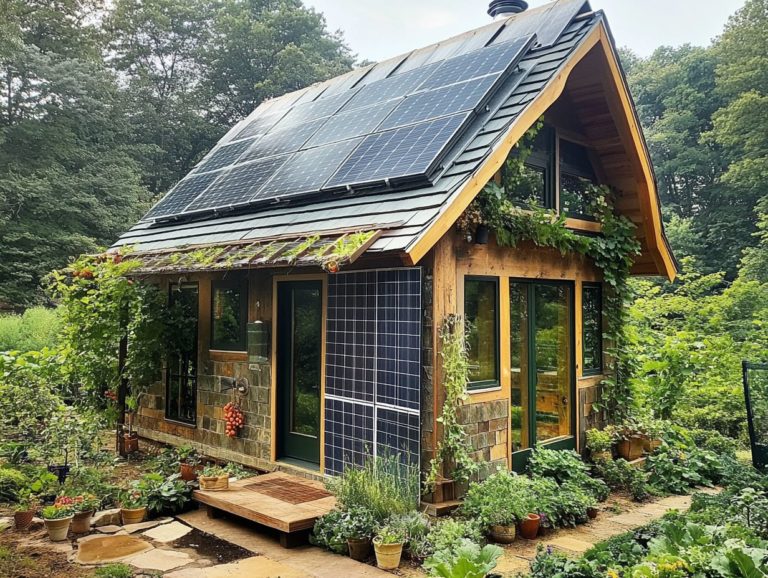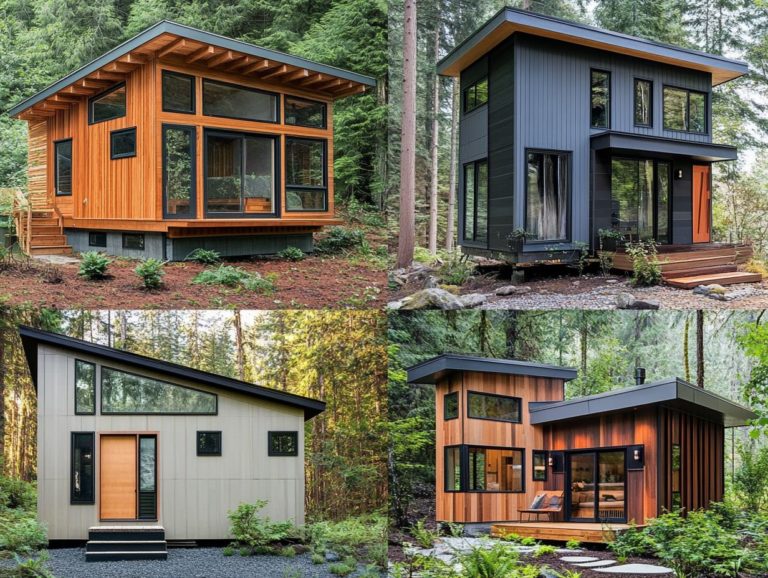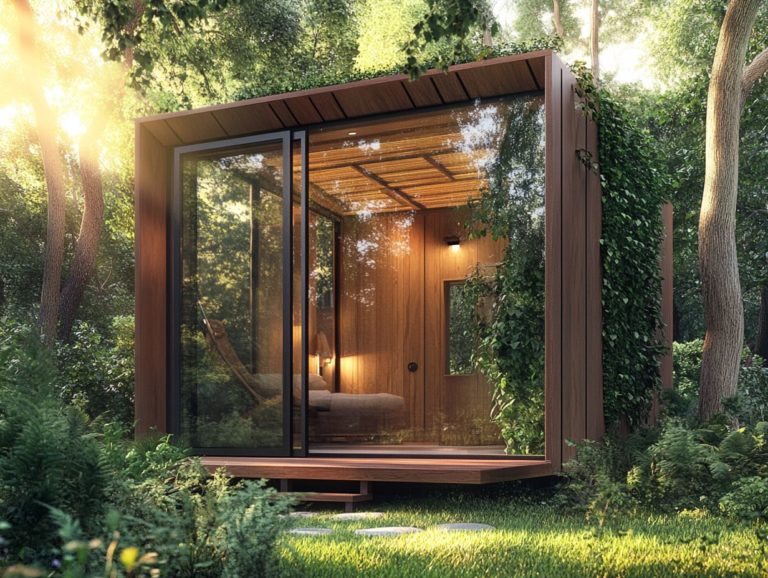The Best Resources for Sustainable Tiny House Materials
Act now! Tiny houses offer an incredible opportunity to embrace sustainability and make a difference. This article explores sustainable materials that not only reduce your environmental impact but also save you money.
Explore the diverse types of sustainable materials perfect for tiny houses, including recycled, renewable, and low-impact options that support sustainable living.
We ll equip you with tips and resources for sourcing these materials, ensuring your tiny home is not only aesthetically pleasing but also gentle on the planet.
Embark on this journey with us to construct a greener future, one tiny house at a time.
Contents
- Key Takeaways:
- Benefits of Using Sustainable Materials in Tiny Houses
- Types of Sustainable Materials for Tiny Houses
- Where to Find Sustainable Materials
- Tips for Incorporating Sustainable Materials into Your Tiny House
- Frequently Asked Questions
- What are the best resources for sustainable tiny house materials?
- How can I find eco-friendly building supply stores?
- Where can I find reclaimed and salvaged materials for my tiny house?
- Are there any online marketplaces specifically for sustainable tiny house materials?
- Can I use materials from my local salvage yard for my tiny house?
- Are there workshops or classes that teach sustainable home building for tiny houses?
Key Takeaways:

- Using sustainable materials in tiny houses benefits both the environment and your wallet through reduced carbon footprint and cost savings.
- Recycled, renewable, and low-impact materials are great options for creating a sustainable tiny house.
- Online resources and local suppliers are valuable for finding sustainable materials. Consider design and installation techniques for effective incorporation.
What are Sustainable Materials?
Sustainable materials are resources that are eco-friendly and can be sourced or made with a minimal carbon footprint. They are essential in modern construction, especially in the tiny house movement, which promotes sustainable living.
Consider using reclaimed wood, recycled materials, and innovative insulation. These not only enhance your home’s efficiency and comfort but also align with a DIY spirit and commitment to The Future of Sustainable Materials in Tiny Housing.
By incorporating sustainable materials, you are actively supporting a circular economy, where materials are reused and recycled to reduce waste. For instance, reclaimed wood sourced from old barns or furniture adds a rustic charm while significantly decreasing the demand for new lumber. Additionally, consider using top sustainable plumbing materials such as recycled steel, which can provide the structural integrity your tiny home needs while cutting down on waste.
Advanced insulation options, like those made from sheep s wool or recycled denim, ensure energy efficiency, creating a cozy atmosphere that helps reduce your heating and cooling costs. By choosing these materials, you re not just constructing a home; you re embracing a lifestyle that prioritizes ecological responsibility and contributes meaningfully to a sustainable future.
Benefits of Using Sustainable Materials in Tiny Houses
Embracing sustainable materials in tiny houses provides a wealth of advantages, from drastically reducing your carbon footprint to enhancing water conservation and realizing potential long-term cost savings. This approach aligns beautifully with the compact design ethos of the tiny house movement.
As a homeowner, your pursuit of efficient, eco-friendly living spaces is increasingly important, making the integration of high-efficiency appliances, smart technologies, and innovative insulation crucial for creating a genuinely sustainable environment.
Environmental Impact and Cost Savings
The environmental impact of incorporating sustainable materials in tiny houses is truly remarkable. You significantly reduce your carbon footprint and promote water conservation, all while enjoying considerable cost savings in the long run thanks to energy efficiency and alternative energy solutions.
By choosing reclaimed wood, recycled metals, and other eco-friendly materials, you not only cut down on greenhouse gas emissions but also benefit from lower utility bills. For example, a study from the National Renewable Energy Laboratory revealed that homes constructed with sustainable materials consume 30-50% less energy. Additionally, understanding the impact of sustainable materials on tiny house value can further enhance your investment.
Pairing solar panels with these sustainable choices can lead to an estimated 70% reduction in electric costs over time, while supporting alternative energy solutions. Such decisions benefit the planet and substantially decrease your long-term expenses.
Join us in making a difference! Start planning your tiny house using sustainable materials today!
Types of Sustainable Materials for Tiny Houses
When building tiny houses, you can choose from many sustainable materials. Use recycled materials to give waste a new life or select renewable materials that can be replaced.
Low-impact materials minimize environmental harm in production and disposal. By thoughtfully incorporating these diverse categories, you can craft homes that reflect your aesthetic sensibilities while promoting a lifestyle of sustainability.
Recycled Materials
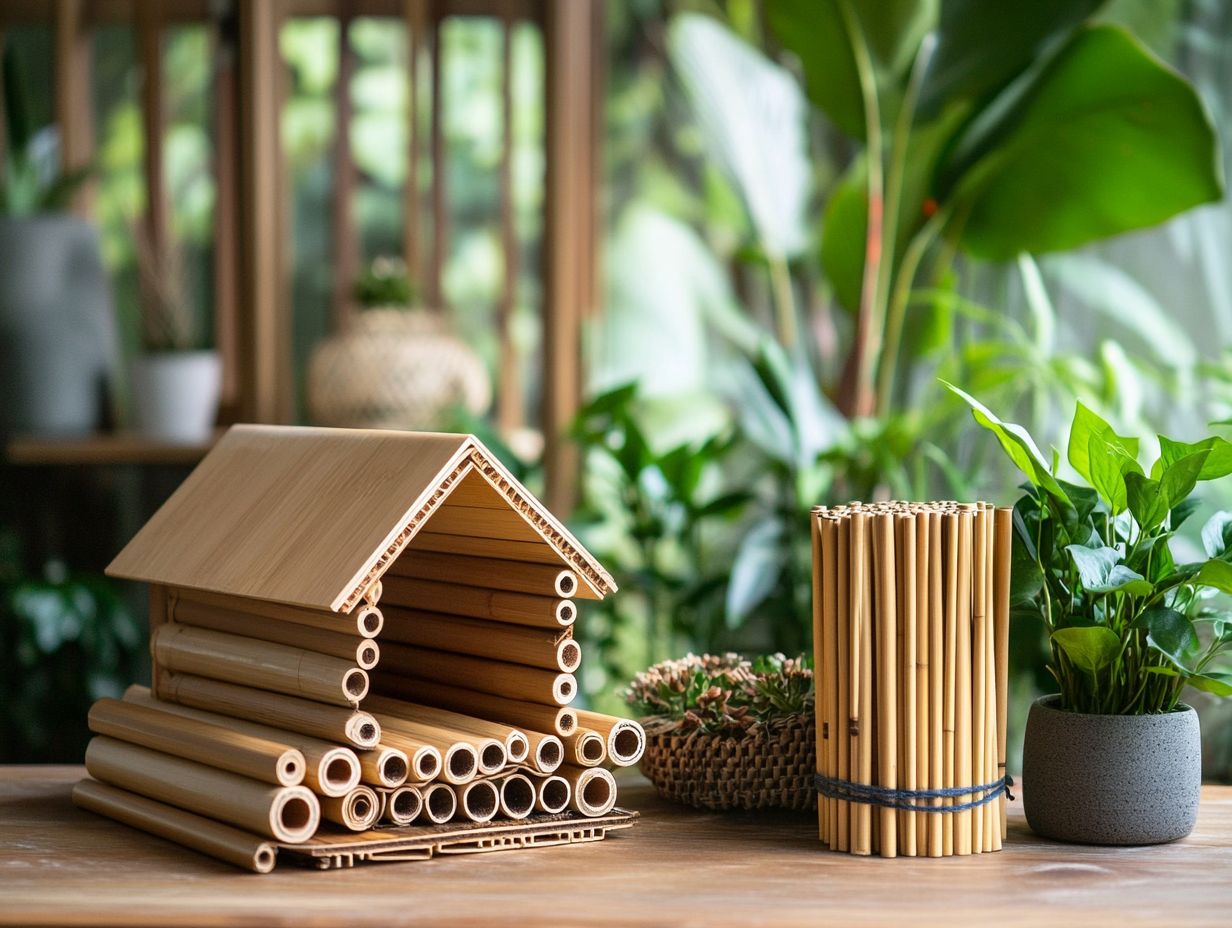
Recycled materials are an important part of sustainable construction. They enable you to reuse waste and make eco-friendly choices.
Reclaimed wood is a favored option in tiny house design. It infuses your living spaces with character and warmth, while significantly reducing the demand for new lumber, aiding forest conservation.
Consider using repurposed metal from old furniture or shipping containers. Recycled glass can also transform your windows or decorative elements into stunning features.
You can often find these materials at local salvage yards, demolition sites, and online marketplaces dedicated to sustainable resources. By embracing these options, you can enhance both the aesthetic appeal and environmental efficiency of tiny homes.
Renewable Materials
Renewable materials, like bamboo flooring, provide a sustainable alternative to traditional building materials. They are a top choice in the tiny house movement.
These materials come from sources that can naturally regenerate over time, reducing reliance on finite resources. Bamboo grows quickly and can be harvested within a few years without harming the ecosystem.
Metal roofing offers durability and is recyclable, minimizing environmental impact at the end of its lifecycle. By choosing renewable materials, builders and homeowners contribute to a healthier planet.
Low-Impact Materials
Low-impact materials are made to reduce harm to the environment. They are essential in sustainable building practices, especially in tiny houses where efficient use of space is crucial.
These materials often feature innovative insulation options, like cellulose made from recycled paper. They provide excellent heat retention and help lower your home’s energy footprint.
Incorporating smart technologies, such as energy-efficient lighting systems, can further optimize your energy usage. Using low-impact materials can also lead to minimal construction waste, fostering a greener lifestyle.
Ultimately, these advancements support a healthier planet and make sustainable living more accessible and appealing.
Where to Find Sustainable Materials
You can discover sustainable materials for building tiny houses through various avenues. Local suppliers, salvage yards, and trustworthy online resources provide a variety of reclaimed materials and eco-friendly options.
With a little exploration, you ll find choices that support your project and align with your commitment to the environment. Start your journey toward sustainability today!
Online Resources
Online resources have become your go-to for sourcing sustainable materials. They offer seamless access to environmentally friendly choices that align perfectly with your DIY ambitions as a tiny house enthusiast.
With platforms like Etsy and EcoGoods at the forefront, you can discover everything from reclaimed wood to organic textiles to elevate your building projects. Explore a fantastic range of choices on marketplaces such as Amazon Handmade and Thrive Market, which provide carefully curated selections of sustainable products. Additionally, understanding the role of sustainability in tiny house construction can enhance your efforts. Local avenues like Facebook Marketplace and Craigslist may also surprise you with hidden treasures.
To ensure the quality and authenticity of your finds, it’s essential to delve into customer reviews, verify certifications, and inquire with suppliers about the sourcing of their materials. Emphasizing transparency is vital for anyone committed to sustainability, including understanding biodegradable materials for tiny houses in their endeavors.
Local Suppliers and Salvage Yards

Local suppliers and salvage yards are true treasure troves for sustainable materials. They offer reclaimed options that minimize waste while infusing your tiny house with unique character.
These resources provide a great range of choices, from reclaimed wood and vintage fixtures to eco-friendly insulation materials. By sourcing your supplies locally, you cut down on transportation emissions, which is great for the planet. Additionally, exploring the top 10 sustainable building techniques for tiny houses can further enhance your efforts. This also bolsters the local economy, creating jobs and nurturing community spirit.
As a tiny house builder, you can explore various salvage yards to unearth hidden gems like old barn wood for rustic charm or repurposed bricks that serve as stunning focal points. To find these suppliers, consider visiting community workshops, joining online forums, or perusing local directories. You’ll discover where to find the most authentic materials for your one-of-a-kind builds, including using recycled materials in tiny house designs.
Tips for Incorporating Sustainable Materials into Your Tiny House
Incorporating sustainable materials into your tiny house demands thoughtful planning and a keen eye for design and installation techniques. Each choice should optimize space and efficiency while elevating your commitment to a sustainable lifestyle.
Design Considerations
When designing a tiny house, several key factors come into play. These include choosing sustainable materials, maximizing natural light, and ensuring that your compact designs promote efficient space utilization.
These choices elevate energy efficiency and enhance the home’s overall aesthetic appeal. For example, selecting reclaimed wood for flooring and cabinets adds unique character while minimizing your environmental footprint. By incorporating large windows or strategically positioned skylights, you invite natural light into the interior, creating a spacious feel that fosters a connection to the outdoors.
Utilizing multi-functional furniture, like a sofa bed or an expandable dining table, captures the essence of tiny living. This cleverly optimizes limited space while maintaining a stylish and uncluttered atmosphere.
Installation Techniques
Effective installation techniques are essential for ensuring the longevity and performance of sustainable materials in tiny houses. This approach allows you to embrace a DIY philosophy that values craftsmanship and attention to detail.
By familiarizing yourself with the specific characteristics of eco-friendly components, you can enhance both energy efficiency and aesthetic appeal in your home. For example, when installing reclaimed wood flooring, it’s vital to let the materials adjust to your living space beforehand to prevent warping. Choosing non-toxic adhesives minimizes your environmental impact while ensuring a strong bond between surfaces. Additionally, understanding the environmental impact of sustainable tiny house materials can help you make informed choices that are better for the planet.
Employing proper sealing techniques is crucial for maximizing insulation efficiency. This leads to reduced energy costs and a more comfortable living environment. Whether tackling small projects or larger installations, these practices empower you to make informed choices that align with your sustainable living goals.
Frequently Asked Questions
What are the best resources for sustainable tiny house materials?
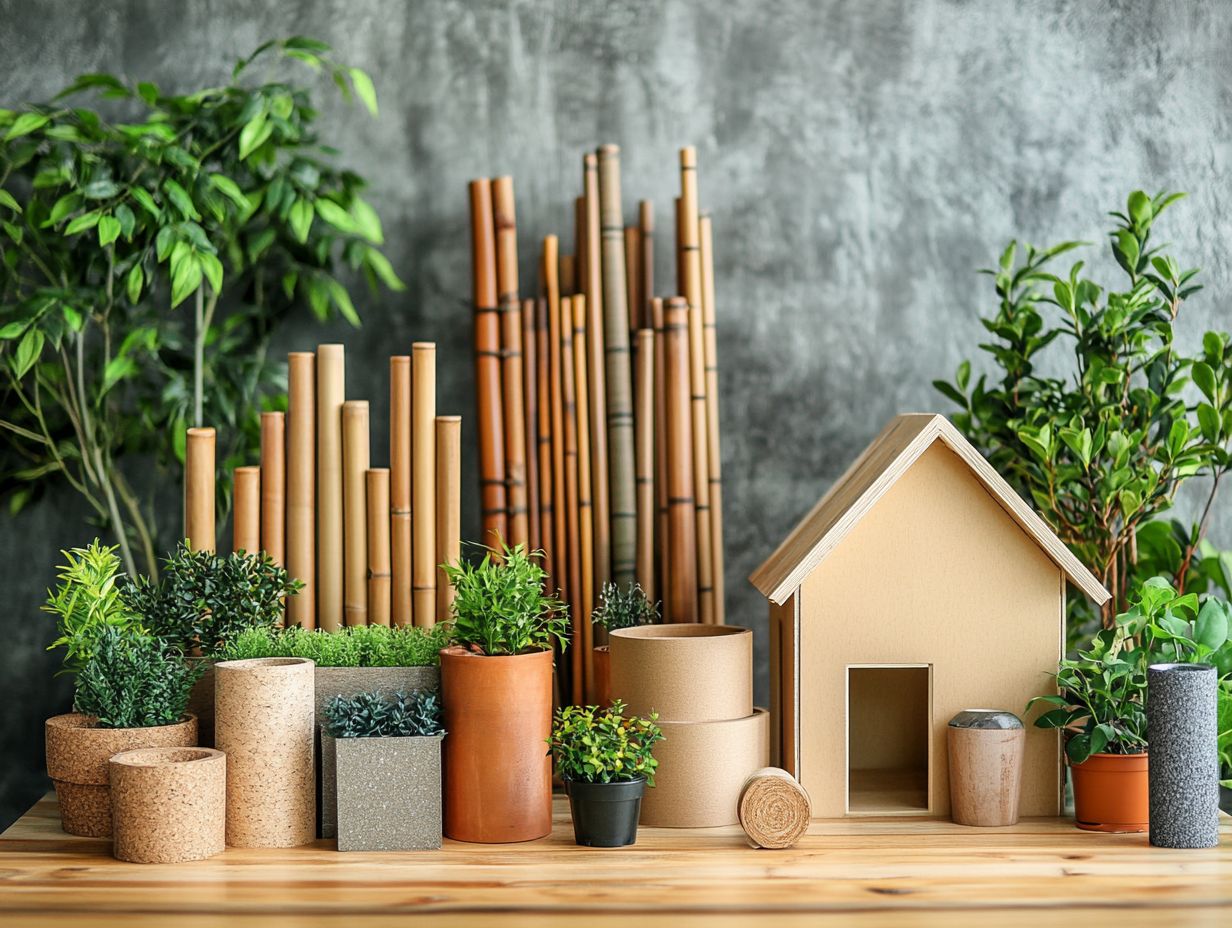
Discover some of the best resources for sustainable tiny house materials. Look for eco-friendly building supply stores, reclaimed materials, and local salvage yards.
How can I find eco-friendly building supply stores?
Search online for stores that sell green building materials in your area. Check with local sustainable building organizations to get recommendations.
Where can I find reclaimed and salvaged materials for my tiny house?
Local salvage yards, flea markets, and online platforms like Craigslist or eBay are great places to find reclaimed materials. Joining online groups can also help you get recommendations from fellow tiny house builders.
Are there any online marketplaces specifically for sustainable tiny house materials?
Yes! Several online marketplaces focus on eco-friendly products for tiny house building. Look into options like Tiny House Marketplace or Tiny House Listings.
Can I use materials from my local salvage yard for my tiny house?
Absolutely! Using materials from a salvage yard adds unique and sustainable features to your tiny house. Just make sure to inspect them for any damage before purchasing.
Are there workshops or classes that teach sustainable home building for tiny houses?
Many workshops and classes focus on sustainable building techniques for tiny houses. Check online or with local organizations to find one near you. Don’t miss out on this opportunity to learn!

